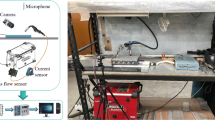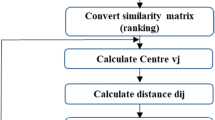Abstract
Weld evaluation processes are usually conducted in the post-weld stage. In this way, defects are found after the weld is completed, often resulting in disposal of expensive material or lengthy repair processes. Simultaneously, weld quality inspections tend to be performed manually by a human, even for an automated weld. Therefore, a proper real-time weld quality monitoring method associated with a decision-making strategy is needed to increase the productivity and automaticity in weld. In this study, acoustic emission (AE) as a real-time monitoring method is introduced for gas metal arc weld. The AE system is designed to cover a wide range of frequencies from 5 to 400 kHz. Additionally, the welding parameters (weld current, voltage, gas flow rate, and heat input) are recorded concurrently with AE. Different types of weld defects are artificially created to generate different signals. For the automated decision-making system, machine learning algorithms are used. Several features extracted from the AE and welding parameters feed into a machine learning algorithm. A new AE feature as the rate of AE energy accumulation extracted from time driven AE feature is defined. For decision-making, supervised learning models are trained and evaluated using testing data. General classification methods—such as Logistic Regression—predict each data-point separately. In this study, Adversarial Sequence Tagging method is applied to predict the presence of four weld states as good, excessive penetration, burn-through, porosity and porosity-excessive penetration. We explore the prediction task as a sequence tagging problem where the label of a data-point depends on its corresponding features as well as neighboring labels. When all the AE features as well as heat input are used in the feature set, the sequence tagging and logistic regression algorithms achieve a prediction accuracy of 91.18% and 82.35%, respectively, as compared to metallographic analysis.









Similar content being viewed by others
References
Ahmed, F., & Kim, K. Y. (2017). Data-driven weld nugget width prediction with decision tree algorithm. Procedia Manufacturing, 10, 1009–1019. https://doi.org/10.1016/j.promfg.2017.07.092.
Bitharas, I., McPherson, N. A., McGhie, W., Roy, D., & Moore, A. J. (2018). Visualisation and optimisation of shielding gas coverage during gas metal arc welding. Journal of Materials Processing Technology, 255, 451–462. https://doi.org/10.1016/j.jmatprotec.2017.11.048.
Casella, G., Fienberg, S., & Olkin, I. (2013). An introduction to statistical learning with statistical learning with applications in R. In G. Allen, R. De Veaux, & R. Nugent (Ed.), Springer texts in statistics. New York: Springer. https://doi.org/10.1016/j.peva.2007.06.006.
Ceschini, L., Boromei, I., Minak, G., Morri, A., & Tarterini, F. (2007). Effect of friction stir welding on microstructure, tensile and fatigue properties of the AA7005/10 vol.% Al2O3p composite. Composites Science and Technology, 67(3–4), 605–615. https://doi.org/10.1016/j.compscitech.2006.07.029.
Chandrasekhar, N., Vasudevan, M., Bhaduri, A. K., & Jayakumar, T. (2015). Intelligent modeling for estimating weld bead width and depth of penetration from infra-red thermal images of the weld pool. Journal of Intelligent Manufacturing, 26(1), 59–71. https://doi.org/10.1007/s10845-013-0762-x.
Chokkalingham, S., Chandrasekhar, N., & Vasudevan, M. (2012). Predicting the depth of penetration and weld bead width from the infra red thermal image of the weld pool using artificial neural network modeling. Journal of Intelligent Manufacturing, 23(5), 1995–2001. https://doi.org/10.1007/s10845-011-0526-4.
Daum, W., Rose, P., Heidt, H., & Builtjes, J. H. (1987). Automatic recognition of weld defects in X-ray inspection. British Journal of Non-destructive Testing, 29(2), 79–82.
Delrue, S., Tabatabaeipour, M., Hettler, J., & Van Den Abeele, K. (2016). Applying a nonlinear, pitch–catch, ultrasonic technique for the detection of kissing bonds in friction stir welds. Ultrasonics, 68, 71–79. https://doi.org/10.1016/j.ultras.2016.02.012.
Doerr, C., Lakocy, A., Kim, J. Y., Singh, P. M., Wall, J. J., Qu, J., & Jacobs, L. J. (2017). Evaluation of the heat-affected zone (HAZ) of a weld joint using nonlinear Rayleigh waves. Materials Letters, 190, 221–224. https://doi.org/10.1016/j.matlet.2017.01.021.
Farson, D. F., & Kim, K. R. (1999). Generation of optical and acoustic emissions in laser weld plumes. Journal of Applied Physics, 85(3), 1329–1336. https://doi.org/10.1063/1.369263.
Gu, H., & Duley, W. W. (1996). Resonant acoustic emission during laser welding of metals. Journal of Physics D: Applied Physics, 29(3), 550. https://doi.org/10.1088/0022-3727/29/3/010.
Kapranov, B. I., & Sutorikhin, V. A. (2017). Remote acoustic emission monitoring of metal ware and welded joints. IOP Conference Series: Materials Science and Engineering, 253(1), 012005. https://doi.org/10.1088/1757-899X/253/1/012005.
Kumar, V., Albert, S. K., Chandrasekhar, N., & Jayapandian, J. (2018). Evaluation of welding skill using probability density distributions and neural network analysis. Measurement, 116, 114–121. https://doi.org/10.1016/j.measurement.2017.11.009.
Li, J., Asif, K., Wang, H., Ziebart, B. D., & Berger-Wolf, T. Y. (2016). Adversarial sequence tagging. In IJCAI (pp. 1690–1696).
Li, L. (2002). A comparative study of ultrasound emission characteristics in laser processing. Applied Surface Science, 186(1–4), 604–610. https://doi.org/10.1016/S0169-4332(01)00695-X.
Lv, N., Xu, Y., Li, S., Yu, X., & Chen, S. (2017). Automated control of welding penetration based on audio sensing technology. Journal of Materials Processing Technology, 250, 81–98. https://doi.org/10.1016/j.jmatprotec.2017.07.005.
Nandhitha, N. M., Manoharan, N., Rani, B. S., Venkatraman, B., & Sundaram, P. K. (2007). Image processing algorithm for quantitative characterization of thermal imaging acquired during on-line weld monitoring. Journal on Intelligent Electronic Systems, 1(1). http://journals-sathyabama.com/archives/iies_abstract.php?id=7.
Park, S. H. C., Sato, Y. S., & Kokawa, H. (2003). Effect of micro-texture on fracture location in friction stir weld of Mg alloy AZ61 during tensile test. Scripta Materialia, 49(2), 161–166. https://doi.org/10.1016/S1359-6462(03)00210-0.
Sreedhar, U., Krishnamurthy, C. V., Balasubramaniam, K., Raghupathy, V. D., & Ravisankar, S. (2012). Automatic defect identification using thermal image analysis for online weld quality monitoring. Journal of Materials Processing Technology, 212(7), 1557–1566. https://doi.org/10.1016/j.jmatprotec.2012.03.002.
Sumesh, A., Rameshkumar, K., Mohandas, K., & Babu, R. S. (2015a). Use of machine learning algorithms for weld quality monitoring using acoustic signature. Procedia Computer Science, 50, 316–322. https://doi.org/10.1016/j.procs.2015a.04.042.
Sumesh, A., Thekkuden, D. T., Nair, B. B., Rameshkumar, K., & Mohandas, K. (2015b). Acoustic signature based weld quality monitoring for SMAW process using data mining algorithms. Applied Mechanics and Materials, 813–814, 1104–1113. https://doi.org/10.4028/www.scientific.net/AMM.813-814.1104.
Tarng, Y. S., Wu, J. L., Yeh, S. S., & Juang, S. C. (1999). Intelligent modelling and optimization of the gas tungsten arc welding process. Journal of Intelligent Manufacturing, 10(1), 73–79. https://doi.org/10.1023/A:1008920631259.
Xu, J., Luo, Y., Zhu, L., Han, J., Zhang, C., & Chen, D. (2019). Effect of shielding gas on the plasma plume in pulsed laser welding. Measurement, 134, 25–32. https://doi.org/10.1016/j.measurement.2018.10.047.
Yang, L., & Jiang, H. (2020). Weld defect classification in radiographic images using unified deep neural network with multi-level features. Journal of Intelligent Manufacturing. https://doi.org/10.1007/s10845-020-01581-2.
Yusof, M. F. M., Kamaruzaman, M. A., Ishak, M., & Ghazali, M. F. (2017). Porosity detection by analyzing arc sound signal acquired during the welding process of gas pipeline steel. International Journal of Advanced Manufacturing Technology, 89(9–12), 3661–3670. https://doi.org/10.1007/s00170-016-9343-4.
Zhang, L., Abbasi, Z., Yuhas, D., Ozevin, D., & Indacochea, E. (2018a). Real-time nondestructive monitoring of the gas tungsten arc welding (GTAW) process by combined airborne acoustic emission and non-contact ultrasonics. In Nondestructive characterization and monitoring of advanced materials, aerospace, civil infrastructure, and transportation XII (Vol. 10599, p. 105991V). International Society for Optics and Photonics. https://doi.org/10.1117/12.2297455.
Zhang, L., Basantes-Defaz, A. C., Ozevin, D., & Indacochea, E. (2018b). Real-time monitoring of welding process using air-coupled ultrasonics and acoustic emission. International Journal of Advanced Manufacturing Technology, 101(5–8), 1623–1634. https://doi.org/10.1007/s00170-018-3042-2.
Zhang, Z., Kannatey-Asibu, E., Chen, S., Huang, Y., & Xu, Y. (2015). Online defect detection of Al alloy in arc welding based on feature extraction of arc spectroscopy signal. International Journal of Advanced Manufacturing Technology, 79(9–12), 2067–2077. https://doi.org/10.1007/s00170-015-6966-9.
Zou, S., Wang, Z., Hu, S., Wang, W., & Cao, Y. (2020). Control of weld penetration depth using relative fluctuation coefficient as feedback. Journal of Intelligent Manufacturing, 31(5), 1203–1213. https://doi.org/10.1007/s10845-019-01506-8.
Acknowledgements
This work was performed with support in part by the Department of the Army through the Digital Manufacturing and Design Innovation Institute under project DMDII 15-14-03 titled as “Intelligent Welding: Real Time Monitoring, Diagnosis, and Decision using Multi-sensor and Machine Learning”. The support from the sponsoring organizations is gratefully acknowledged. The authors would like to thank ITW (Illinois Tool Works) Miller and John Deere for proving welding equipment and the data acquisition system and David Pivonka, Ryan M Gneiting and Sankaran Subramaniam for their valuable inputs into the experimental design and sample preparation. Any opinions, findings, and conclusions or recommendations expressed in this paper are those of the authors and do not necessarily reflect the views of the organizations acknowledged above.
Author information
Authors and Affiliations
Corresponding author
Additional information
Publisher's Note
Springer Nature remains neutral with regard to jurisdictional claims in published maps and institutional affiliations.
Rights and permissions
About this article
Cite this article
Asif, K., Zhang, L., Derrible, S. et al. Machine learning model to predict welding quality using air-coupled acoustic emission and weld inputs. J Intell Manuf 33, 881–895 (2022). https://doi.org/10.1007/s10845-020-01667-x
Received:
Accepted:
Published:
Issue Date:
DOI: https://doi.org/10.1007/s10845-020-01667-x




